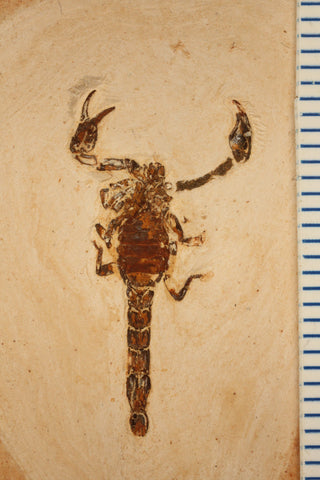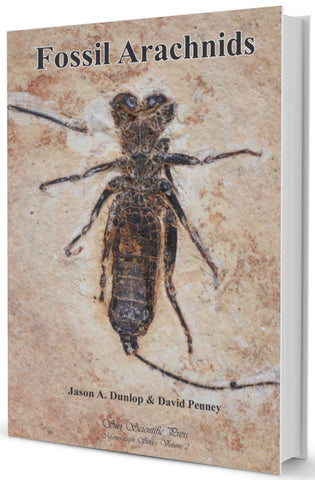New Fossil Scorpion 290 Million-Years-Old Sheds Important Light on their Evolutionary History
Posted by David Penney on
Scorpion fossils are possibly more diverse than you might expect. 128 fossil species are currently recognized, with some dating back as far as the Silurian period. They occur in various different rock types and also, more rarely, as inclusions in amber.
Fossil scorpion from the Cretaceous Crato Formation, Brazil
A new discovery, representing the first complete scorpions from the Permian period, has just been announced at a conference held in Germany. The fossils originate from a recently excavated locality in Chemnitz, Germany. It appears that explosive volcanism preserved the remarkable specimens in situ as part of the palaeosol and bedrock of the Petrified Forest, in an assemblage that dates back 290 million years to the early Permian (Sakmarian).
As for scorpions today, they were probably notable predators of other arthropods, and perhaps even small vertebrates. Morphological details of the pectinal teeth (the comb-like structures unique to scorpions) in the two fossils imply sexual dimorphism, with both a male and a female preserved close to one another and possibly representing a mating pair.
As putative members of an older Coal Measures genus, these fossils suggest that some Carboniferous scorpion lineages extended their range further into the Permian, thus contributing towards a picture of scorpion evolution in which both primitive and more derived forms coexisted for quite some time; probably from the end of the Carboniferous through to at least the mid-Triassic. The formal description of these fossils is currently in preparation by Dr Jason Dunlop and colleagues.

A Carboniferous Coal Measures scorpion from Sparth Bottoms, Rochdale, UK, just down the road from our offices and currently on display at Manchester Museum!
Unfortunately the taxonomy of fossil scorpions is currently rather messy and a considerable amount of work is required to resolve this issue. If you would like to find out more about the evolutionary history of this remarkably long-lived group, in addition to their other arachnid relatives, you can do so in our volume Fossil Arachnids co-authored by Jason Dunlop, one of the researchers involved with the new discovery.
Reviews
ZooKeys (2012): “... absolutely unique within the arachnological literature to date. There is barely any overlap with previously published books, which usually only briefly touch on the fossil record. It will fill a long-standing void on the shelves of arachnological libraries, and will be of interest to palaeontologists and neontologists alike, both as a source of reference or merely to browse through the stunning images it contains.”
Priscum (2015) [slightly modified as the original review related to two SSP volumes]: The last detailed review of the arachnid fossil record appeared in 1955, in one of the earliest published volumes of the Treatise on Invertebrate Paleontology, written by Alexander Petrunkevitch. Since then, our knowledge of modern and fossil arachnids has increased exponentially. ... You might want to purchase it just for the beautiful color photos of the specimens, in particular those from amber. ... The best comparison to this excellent monograph is the magisterial volume by Grimaldi and Engel on the History of Insects. This likewise should be in the library of every student of fossil arthropods and modern arachnids and of anyone interested in the evolution of terrestrial biotas.
Full reference for the new scorpion discovery: Rößler, R., Luthardt, L., Dunlop, J., Legg, D., Fet, V., Selden, P. A. & Schneider, J. W. 2015. First complete scorpions from the Permian: in situ finds and exuvia from a seasonally influenced forest habitat (Chemnitz Basin, Leukersdorf Formation, Germany). Jahrestagung der Paläontologischen Gesellschaft, ZfB Schiffweiler-Reden, 14–16 September 2015.
Share this post
- 0 comment
- Tags: Monograph series, New research, News
0 comment


